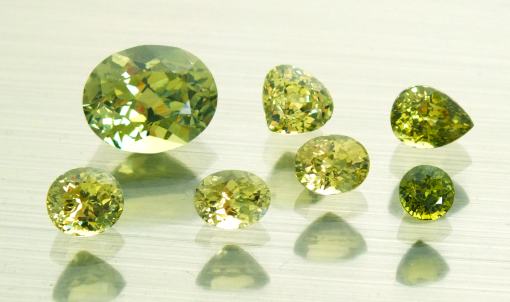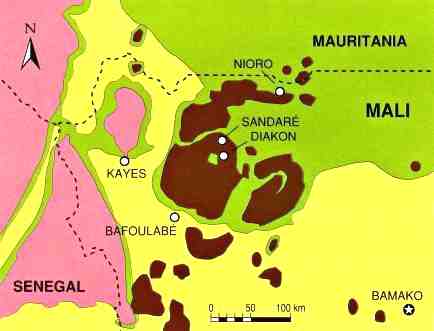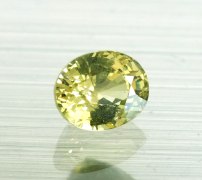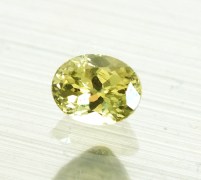 |
| Grossular-Andradite
Garnet 0.78 - 5.83ct Rep. of Mali |
�@
�@
�O�����_�C�g��K�[�l�b�g�i�}���E�K�[�l�b�g�j
(Grandite�FGrossular-Andradite
Garnet/Mali�EGarnet�j
�@
 |
| Grossular-Andradite
Garnet 0.78 - 5.83ct Rep. of Mali |
| ���w�g�� (Composition) |
�����` (Crystal System) |
���[�X�d�x (Hardness) |
��d (Density) |
���ܗ� (Refractive Index) |
| (Ca,Fe)3Al2(SiO4)3 | �������n (Cubic) |
7 | 3.64�|68 | 1.752�|782 |
�@
�@1994�N�A�A�t���J�̃}�����a������A�W�ΐF�A�W���F�A��|���F�̑��ʂȐF���������K�[�l�b�g���o�ꂵ�܂����B
���͂̌��ʃO���V�����[���C�g���������悻80���ƃA���h���_�C�g����20������Ȃ�V�����^�C�v�̃K�[�l�b�g�Ɣ������܂����B
�@���������x�Ɣ������F�����A����ɍ������ܗ��ɂ��ῂ���������ΊE�̒��ڂ���Ƃ���ƂȂ��āA�O���V�����[��A���h���_�C�g�i�O�����_�C�g�j,��ʂɂ̓}���E�K�[�l�b�g�A�}����O���V�����[��K�[�l�b�g�̌Ăі��������܂��̂����ɒ蒅���܂����B
�@�V�����K�[�l�b�g�̎Y�n�̓A�t���J�̃}�����a���Ő��[�A�Z�l�K���ƃ��[���^�j�A�̍����߂��̃T�n�������ɂ���܂��B
�h���E�ň��̗��h �̌��̉����̓s�s�A�g���u�N�g�D�[�̐�500km���̒n�Ƃ����ǂ�ȏꏊ���z���������ƂƎv���܂��B
�@In 1994, new gem garnets with varieties of colors : primarily yellow-green to brown but also (rarely) intense green, appeared on the market from Republic of Mali, Western Africa. This new garnet have compostions between grossular and andradite. Although garnets of similar compositions are relatively well known, this is the first documented occurence of gem-quality material in commercial quantities.
�@A new garnet of high transparency, pleasing colors and brilliance thanks to it's high refractive index immediately attracted gem trade. Now this garnet is widely promoted under "Mali garnet", or Grandite, short-handed term for "Grossular-Andradite".
�n���ƎY��iGeology and Occurence�j
 |
�O�J���u���A�I(Precambrian)�@: �`�@5.7���N(570 MY) | ||
| �O�J���u���A�I�Ō���@�`�@�J���u���A�I �iUppermost Cambrian and Precambrian�j | |||
| �V�����I�iSilurian�j: 4.3�` 4���N(430 - 400MY) | |||
| �P�Ί�̊ѓ��n�сiDiabase and relative intrusives�j | |||
 |
 | ||
| ��Ύ��c��@25ct �iGemmy nodule)�j |
���� 36x27x22mm
192ct (Grandite crystal) | ||
�@�}�������͑O�J���u���A�I�̃A�t���J���藤��ɕ����Ă��܂��B
�J���u���A�I����V�����I�i5.7���N�`�S���N�́j�̋�D��ƐΊD�₩��Ȃ�͐ϑw�Ɏ�ɋP�Ί▬���ѓ������ڐG�ϐ���p�ŗΗ��A�����A壐A�x�X�u�C���ɋ��ΐƋ��ɒў��Y�o���܂��B
�@Western Mali is underlain by the Precambrian West African Craton, which fill the western part of the basin and are overlain by Mesozoic deposits to the east. Garnets formed in contact metamorphic zones along the boundaries where the widely scattered diabase dikes intruded into limestones. Besides garnet, the minerals that formed in the contact zone between diabase and limestone include epidote, vesvianite, prehnite, fluorite, and occasionally chrysoberyl.
�@�ў͎��ɂ͂P�Ocm����قǂ̑傫�ȕΕH�P�Q�ʑ̂̌����Ƃ��ĎY�o���܂����C�����͖w�Ǖs�����ł��B�����̓����̋͂��ȓ����ȕ�������Ƃ��ăJ�b�g����܂��B
���̕����܂肽���A200kg�̌�������160g�̓����ȉ����A���̂���60g����Ύ��ŁA�J�b�g����ƍŏI�I��0.015���ɉ߂��Ȃ�30g�i150ct�j�̃��[�X��������ƌ�������B
�@���͂��̃K�[�l�b�g�̑��݂�1914�N�ɂ͕���Ă��܂������A�܂������̕s�����Ȍ�������ɂȂ�Ƃ͋C�Â���Ȃ��܂�80�N�Ԃ����߂�����Ă����̂ł��B
�@�ʏ�A�قȂ鐬�������������ŗe�̂Ƃ��ĎY����K�[�l�b�g�ł����瑼�̎Y�n����ǂ������F�������������K�[�l�b�g����������Ȃ��킯�ł͂���܂���B
�������Ȃ���A�@���ɔ������낤�ƁA�������ʂ��H�ɔ�������Ă��V��Ƃ��Ęb��ɂ͂Ȃ�܂���B
�@�}���ŐV���ɔ������ꂽ�O�����_�C�g�̏ꍇ�́A�ɂ߂ĒႢ�����܂�Ȃ���A�T������km�̍L��ȎY�n����N�Ԑ����J���b�g�ƈ��肵���Y�o�������߂邽�ߕ�ƊE�̒��ڂ��W�߂鎖�ɂȂ�܂����B
�@Although garnets from this region have been known since 1914, almost opaque dodecahedral crystals, sometimes as large as 10cm diameter, were disregarded for about 80 years, because a few gemmy part is recovered only in the core of crystals :
a parcel of 400-500 crystals, weighing about 200kg, yields 160 grams of nodules, from which only 60 grams would be facet grade. Of these 60 grams(300ct) of facet-grade rough, perhaps 150ct of faceted gems result : a total yield of 0.015%.
�@Since almost all garnets are found as solid solution (mixture of various types), garnets of similar colors and compositions as Mali-garnet are found in world localities. However, a sporadic and limited finds of rare species do not appeal to the gem trade. Mali grandite is, despite its extremely low yield, estimated annual supply of several tens of thousand carat gems from 50,000 k�u�@of vast area is promising enough for gem trade to promote this new garnet.
�O�����_�C�g�̐F���� (Colors of grandite)
Grossular 6.37ct
R.I. 1.745.83ct
12.30x9.86x6.83mm1.72ct
7.0x6.5x5.4mm1.73ct
7.7x5.8mm�ő�̃O�����_�C�g�@57.5ct
(The largest grandite)
 |
 |
 |
 |
| 2.31ct 10.1x7.1mm | 1.26ct 6.7x5.4mm | 1.07ct 6.7x5.2mm | 0.78ct 5.1x5.0mm |
�@ �ʐ^�̂悤�ɗ�����F�A���F�܂ő��ʂȐF������܂����C���L�Ɏ����悤�ɐΖ��i���邢�͓����ł����F�̏ꍇ�ɂ́C�قȂ�F�̕������j�ɐ������قȂ�܂��@�G
�@As shown on photos, grandite has wide varieties of colors, which are explained with different compositions in the following chart ;
�F(Color) �����䗦�i�������j
(Compostion : Mol%)���F�v��
(Coloring agent)���ܗ�
(Refaractive Index)��d
(Density)Grossular Andradite �@Pyrope�@ Uvarovite �Z��(Dark green) 79 16 3 2 �N����(Cr) 1.762�|764 3.65�|67 ��(Green) 73 25 2 - �@�S(Fe) 1.752�|769 3.64-68 ����(Yellowish green) 80 18 2 - �@�S(Fe) 1.752�|769 3.64�|68 ��|��(Orange - Brown) 30-34 65-68 2 - �@�S(Fe) 1.773�|779 3.67�|68
�@��̎ʐ^��6.3�J���b�g�̃y�A�J�b�g�̃��[�X�͋��ܗ���1.74�ƒႭ�A�w�ǃO���V�����[���������̂��̂�����܂��B
��F�`���F�̂��̂̓A���h���_�C�g�����䂪�����A���ܗ����������������������߁A�V�����p����R�j���b�N��J���[�̃I�[�X�g�����A�Y�̊��F�̃_�C�A�����h��֕i�Ƃ��Ă̗p�r������܂��B
�@�`���͂����Ƃ��ʂ������̂ŋH���ȃ^���U�j�A�̃O���V�����[��K�[�l�b�g��u���W���C�X�������J�Y�̃N���\�x�����̑�֕i�Ƃ��Đl�C������܂��B
�����ċH�ȃG�������h��O���[���̂��̂́A�Y�o�̏��Ȃ��P�j�A�̃c�@���H���C�g��ɂ߂ċH�ȃf�}���g�C�h�̑�֕i�Ƃ��Ē��d����Ă��܂��B
�@Mali garnet's composition extends from grossular toward andradite. Most gem-quality grossular-andradites from Mali are reminiscent of pale yellowo to green grossular from Tanzania, and are similar in appearance to crysoberyls from Srilanka and Brazil. There are also numerous brown to brownish orange stones which can be quite brilliant, due to their (andradite-derived) higher R.I.'s and dispersions. These may serve as inexpensive substitutes for "cognac" diamonds. Although only a few intense green stones have been found so far, they are praised to substitute, the current low supply of tsavorite and the exttreme rarity of fine demantoids.